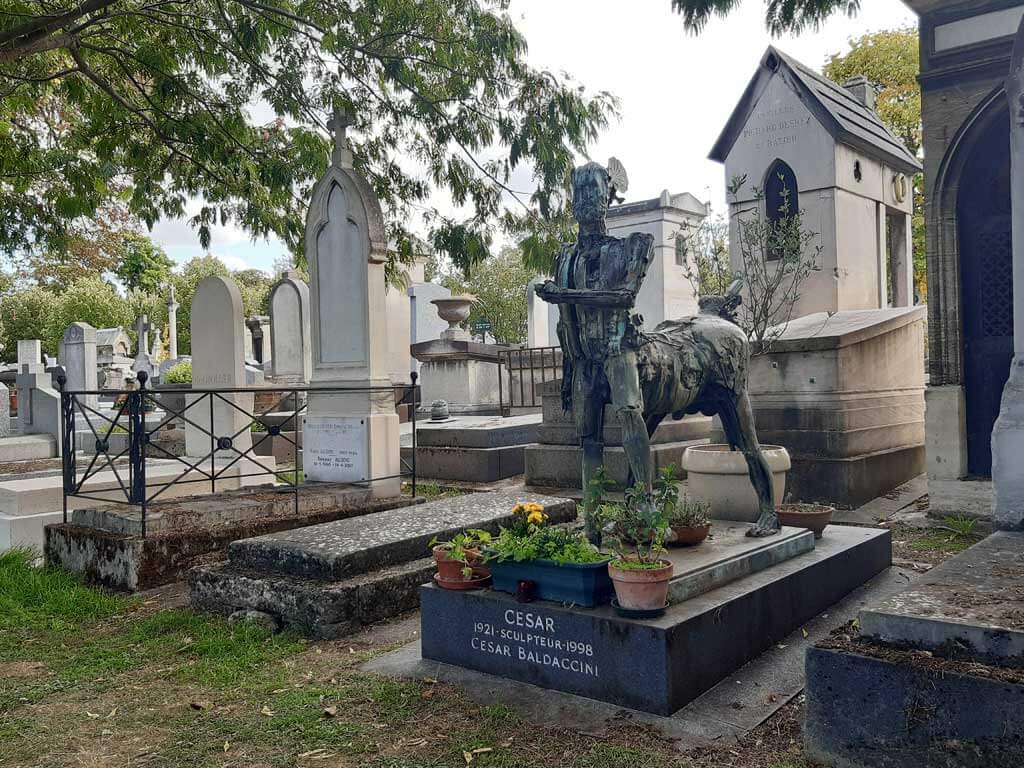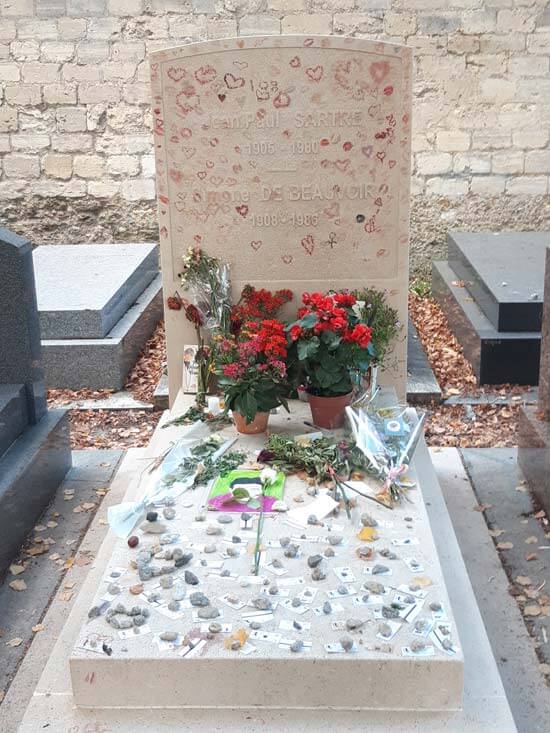Visit Cemetery Montparnasse on Paris’ Left Bank
The Montparnasse Cemetery is one of the most beautiful cemeteries in Paris and the second largest cemetery in the city only after the Père Lachaise Cemetery. Located in the neighborhood of Montparnasse (Paris 14) and enclosed by high walls, this cemetery is practically invisible from the outside.
The cemetery’s main entrance is on Boulevard Edgard-Quinet and covers an area of 19 hectares. As of today, it has 35,000 graves and 1,200 trees, mainly lime trees, sophoras, cedars, maples, ashes, and conifers.
Not far from Parc Montsouris, the Paris Catacombs, and other underground attractions in Paris, a visit to this famous Paris cemetery makes it easy to combine some of these interesting attractions in the neighborhood.

History of the Montparnasse Cemetery

The Cemetery of Montparnasse was inaugurated in 1824, twenty years after the Père Lachaise Cemetery, for the residents of the Left Bank. At the beginning of the 19th century, Nicolas Frochot, prefect of the Seine, purchased this land to open one of the three cemeteries outside Paris. Before this date, the area was a dumping ground for the neighboring quarries.
In the 17th century, the monks of the Hôtel-Dieu owned the place and built windmills there. The revolutionary era confiscated the property of the religious; then, the space welcomed the sentenced to death and the deceased whose bodies were not claimed in the hospitals of the capital.
Opened in 1824, the cemetery was enlarged in 1847. In 1878, the Montparnasse Cemetery was cut in two by Rue Emile Richard and narrowed due to the opening of Rue Schoelcher and Rue Considerant.
Although it does not have the elegance of Père-Lachaise Cemetery or the Montmartre Cemetery, the Cemetery Montparnasse has a very large number of interesting tombs, especially of artists and writers. If Père-Lachaise was the great cemetery of the 19th century, Montparnasse was certainly the famous Paris cemetery of the 20th century.

Throughout its history, the Montparnasse Cemetery contained various particular enclosures:
– The hospital cemetery: was abolished in 1861 and transferred to the Cemetery of Ivry.
– The Jewish cemetery: was maintained until its destruction in 1881. Today, there are no more confessional enclosures.
– The trench of the Invalides: the old cemetery of Vaugirard ceased to receive the bodies of the Invalides in 1833. After that year, the bodies were buried in the cemetery assigned to the district of the Hôtel des Invalides, namely Montparnasse. These burials, in free trenches, took place until 1873.
– A strip of land in this cemetery was dedicated to the executed. From 1882, these were conducted at the Cemetery of Ivry.
The Montparnasse Cemetery was desecrated in 1849. Various corpses of women were found out of their graves mutilated. The culprit was quickly discovered, a necrophiliac sergeant who was sentenced to one year in prison.
What to See in Montparnasse Cemetery – Famous Graves & More

The Montparnasse Cemetery is known as the “Southern Cemetery” in opposition to the more famous Paris cemetery Père Lachaise, located on the Seine’s Right Bank. It is a beautiful and quiet place for a walk in the middle of the hustle and bustle that is Paris.
Lesser known by tourists than the Père Lachaise, the Montparnasse Cemetery has nothing to envy to the highly coveted cemetery on the Right Bank. With its 19 hectares, it’s the last home of a considerable number of celebrities in the world of the arts, literature, and cinema.
Who is Buried in Montparnasse Cemetery?
The list of famous people buried in the Montparnasse Cemetery is long, and it is displayed next to the map of Montparnasse Cemetery that pinpoints the exact location of their tombs. The Montparnasse Cemetery Map is displayed on big panels located along the main alleys.

Here, visitors can pay their respects to French celebrities like Jean-Paul Sartre and Simone de Beauvoir, Simone Veil (who recently entered the Panthéon of Paris with her husband, even if only symbolically), President Jacques Chirac, Serge Reggiani, the giants of French cinema Jean Poiret, and Philippe Noiret; writers, artists, and other famous people like Charles Baudelaire, Guy de Maupassant, Littré, Pierre Larousse, Flammarion, Raspail, Laurens, Chauveau Lagarde, Serge Gainsbourg, Antoine Bourdelle, Alfred Dreyfus, Louis Hachette, Edgar Quinet, André Citroën, Dreyfus, Bastié, Marguerite Duras, Conte, Orfila, Jussieu, Auguste Bartholdi, and many, many more.


In the Cemetery Montparnasse, it is easy to understand the presence of foreign visitors who come to pay homage to their compatriots. The Montparnasse Cemetery is also home to Porfirio Diaz (President of Mexico), Shapour Bakhtiar (Iranian political leader), and Romanian artists and authors such as Brassai, Brancusi, Tzara, and Ionesco. There is also the American photographer Man Ray, the Argentinian poet Julio Cortazar, the Irish author Samuel Beckett, the Russians Alekhine (chess champion) and Zadkine, the Lithuanian painter Chaïm Soutine… only to name a few.

In Montparnasse Cemetery, famous graves and anonymous graves are watched by one of the few flour mills still existing in Paris (the others are located in Montmartre). Standing in the middle of 35,000 graves, this (today) listed historical monument is the only heritage left from those monks of the 17th century, and it was used to host the guardian when the cemetery opened. Today, the mill does not host the cemetery’s guardian anymore, but visitors can take picturesque shots of the mill and the Montparnasse Tower (past and present) together.
Montparnasse Cemetery – Practical Information

Opening times: Monday to Friday, 8 am to 5.30 pm; Saturday, 8.30 am to 5.30 pm; Sunday, 9 am to 5.30 pm.
Point of access: 3 Boulevard Edgar Quinet, Paris 14 (main entrance); we entered through Rue Froidevaux, and then Rue Emile Richard.
Nearest metro stations: Gaité-Joséphine Baker (line 13), Raspail (lines 4 and 6), Edgar Quinet (line 6).
What to See Near the Cemetery Montparnasse
- Paris Catacombs
- Tour Montparnasse
- Parc de Montsouris
- Musee de la Libération de Paris
- Carrières des Capucins
- Institut Giacometti
- Fondation Cartier pour l’Art Contemporain
- The Luxembourg Gardens

